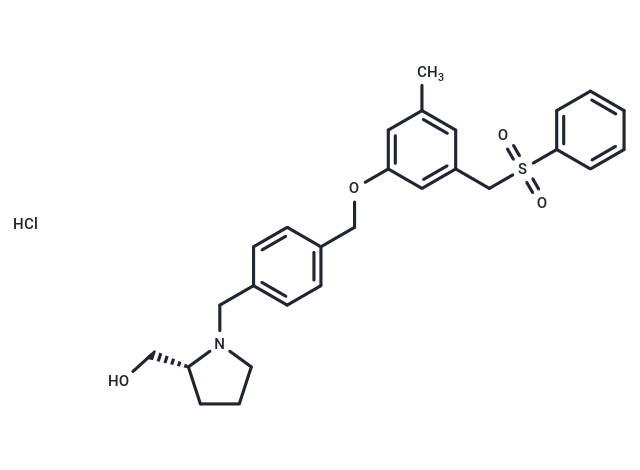Shopping Cart
- Remove All
 Your shopping cart is currently empty
Your shopping cart is currently empty

PF-543 hydrochloride (PF-543) inhibits SphK1 with a K(i) of 3.6 nM, is sphingosine-competitive and is more than 100-fold selective for SphK1 over the SphK2 isoform.

| Pack Size | Price | Availability | Quantity |
|---|---|---|---|
| 1 mg | $33 | In Stock | |
| 5 mg | $70 | In Stock | |
| 10 mg | $137 | In Stock | |
| 25 mg | $248 | In Stock | |
| 50 mg | $335 | In Stock | |
| 100 mg | $513 | In Stock | |
| 1 mL x 10 mM (in DMSO) | $105 | In Stock |
| Description | PF-543 hydrochloride (PF-543) inhibits SphK1 with a K(i) of 3.6 nM, is sphingosine-competitive and is more than 100-fold selective for SphK1 over the SphK2 isoform. |
| Targets&IC50 | SPHK1:3.6 nM (Ki), SPHK1:2 nM (IC50), S1P1:26.7 nM (IC50) |
| In vitro | SphK1 inhibition by PF-543 causes a dose-dependent depletion of the intracellular level of S1P with EC50 concentration of 8.4 nM and a concomitant elevation of the intracellular level of sphingosine in 1483 cells. The level of endogenous S1P in 1483 cells after a 1 h treatment with 200 nM PF-543 is decreased 10-fold, producing a proportional increase in the level of sphingosine. |
| In vivo | PF543 was found to be a potent inhibitor (IC50 = 26.7 nM) capable of blocking >90% of C17-S1P formation in the blood. |
| Alias | PF-543 HCL |
| Molecular Weight | 502.1 |
| Formula | C27H32ClNO4S |
| Cas No. | 1706522-79-3 |
| Smiles | Cl.Cc1cc(CS(=O)(=O)c2ccccc2)cc(OCc2ccc(CN3CCC[C@@H]3CO)cc2)c1 |
| Relative Density. | no data available |
| Storage | Powder: -20°C for 3 years | In solvent: -80°C for 1 year | Shipping with blue ice. | |||||||||||||||||||||||||||||||||||
| Solubility Information | DMSO: 90 mg/mL (179.25 mM), Sonication is recommended. | |||||||||||||||||||||||||||||||||||
Solution Preparation Table | ||||||||||||||||||||||||||||||||||||
DMSO
| ||||||||||||||||||||||||||||||||||||

Copyright © 2015-2025 TargetMol Chemicals Inc. All Rights Reserved.